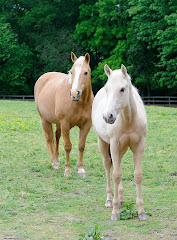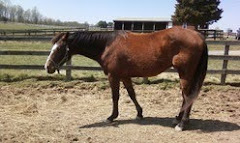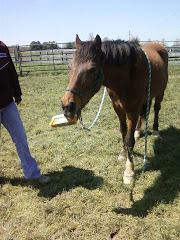It started innocently enough. Three weeks ago, on a Monday morning, I went out to ride my horse and noticed that the end of his nose and his muzzle were a funny yellowish orange color. My horse, Sonny, is a paint with a big white blaze so the end of his nose and muzzle are normally pink. I didn’t think too much of it at the time. The dirt in this part of Maryland is primarily clay and I thought Sonny, who loves food more than life, had probably been rooting around in the dirt. I rode Sonny and we had a really good session. I was able to ride for 20 minutes without using my reins, which is a big deal for me and he was responding beautifully to changes in body weight and leg pressure and going forward without much urging. I was really happy with him when we finished.
I didn’t go to the farm on Tuesday, but that evening, I received a text message from the barn manager that Sonny’s nose was very sunburned and she wanted me to bring down his UV fly mask. I thought it was odd that he had gotten sunburned this early in the season but he does have that big white nose so I put the mask in my car and didn’t think anything more of it. When I saw Sonny on Wednesday morning, though, I got worried. This didn’t look like an ordinary case of sunburn. His nose was a mess. The skin was angry looking, cracked and blistered, and it was still that funny yellowish orange color. But now I noticed that in addition to the color on his muzzle, the white of his eyes looked very yellow. I decided that I better have the vet take a look at it.
Our vet, Dr. Clark Cushing, lives fairly close to the barn so he arrived fairly quickly. He took one look at Sonny’s nose and shook his head.
“That doesn’t look too good.” He commented as he pulled Sonny’s lips back and looked at the inside of his mouth. Instead of being a nice pink color, Sonny’s tongue and the inside of his mouth looked a bit yellowish.
“What do you think it is?” I asked.
“Looks to me like he ate something he shouldn’t have. There are a lot of potentially toxic plants that he could have gotten into and some of them cause light sensitivity, but I won’t know for sure until I check his blood,” he said.
Dr. Cushing drew two vials of blood and told me that he wanted to check Sonny’s liver enzymes because he looked a bit jaundiced and he told me to keep Sonny out of the sun. I covered his nose blisters with Desitin, my ointment of choice for sunburn, and turned him back out into his pasture which has a fair amount of shade.
I had just gotten home when the vet called and told me that Sonny’s liver enzymes were way out of whack and it looked to him like Sonny had eaten something that was toxic. We needed to give him fluids to flush the toxins out of his system. So I rushed back to the barn and spent about 90 minutes holding bags of fluids on the end of a pitchfork to keep them higher than Sonny’s heart so the fluids would flow properly.
While we were waiting, I questioned Dr. Cushing about what could have caused this problem. The pastures at our farm are in pretty good shape with not much weed growth and the particular pasture that Sonny had been turned out in was actually mostly clover.
“I’ll take a walk through the field and see if I can see anything,” Dr. Cushing said. “But the problem actually could be the clover. There is a type of clover called alsike clover that is known to cause this kind of problem.”
“I’ve never heard of clover being toxic”, I told him.
“That’s because the problem with this kind of clover is intermittent and it doesn’t affect all horses that are on it”, Dr. Cushing told me. “It is mostly seen in the spring and fall, when the weather has been wet. But it is known to cause liver problems and there is a photosensitive chemical in the clover, that when it gets in to the horse’s blood causes the problems with burns. You see it on the white areas because the blood vessels are so close to the skin and not well protected by the hair.”
Sonny had been turned out with three other horses and at this point, only one other was showing signs of being affected. That horse was a palomino with a wide white blaze and she was also much burned on her nose. After we were done giving fluids to the two horses, Dr. Cushing walked the field and the only think he could see that could be toxic was the alsike clover. He told us that we needed to keep the two horses out of the sun, gave us some antibiotic ointment to put on their sunburned noses and said he would check back in a couple of days.
Returning home, I immediately hopped onto the internet to see what I could learn about alsike clover toxicity. What I read on a number of different web sites is that alsike clover actually causes two separate problems in horses, photosensitivity and “big liver disease”. The photosensitivity apparently results when the liver is overstressed and cannot properly clean the blood of the products of chlorophyll metabolism. When the horse is exposed to sunlight, the skin will redden and crack before sloughing off. It will be most apparent in the unpigmented pink skin areas and here may also be serous edema, with excessive fluid collecting in the effected areas. Fortunately the symptoms will clear up when the horse is removed from the clover and there is usually no permanent damage if the situation is corrected quickly enough and no secondary infection occurs.
The other problem, “big liver disease” is less well understood but if the horse has alsike clover in it diet for a long time, the liver can suffer permanent damage. Jaundice can be an early symptom. If allowed to progress, cirrhosis causes the liver to enlarge and if left untreated, can result in death.
In order to ensure that we had flushed all of the toxins out of Sonny’s system, Dr. Cushing came back to the farm and gave him a dose of water, mineral oil and Epson salts. He also gave him a shot of banamine for the pain, steroids to promote healing and some Lasix to help prevent fluid build up. Sonny continued to eat well but after a couple of days of standing in his stall all day, I noticed that his legs were beginning to stock up. That didn’t concern me too much at first but after another day, I noticed that all three of his white legs were quite swollen while his one chestnut leg was not. He was beginning to look like the Pillsbury dough boy! In addition, his back legs were so swollen that serum was beginning to leak through the skin. I called the vet again.
For the next two weeks we fought the swelling. The vet prescribed a steroid with a mild diuretic to help keep the swelling at bay and he also instructed me to walk Sonny every couple of hours. Fortunately, the farm has a lot of shade, so Sonny and I began walking every couple of hours. As worried as I was about him, I was trying to use these walks as a way to continue building our relationship, spending undemanding time with Sonny grazing in the shade of the trees.
After a week of treatment, Sonny’s coloring had gone back to its normal pick and his nose was healing nicely but his legs were still very swollen. The vet was very worried about secondary infection with his legs and treated him with an antibiotic as a preventative. By the end of the 2nd week of treatment, the swelling in his legs was pretty much under control and the vet cleared him to go out at night. He is starting to lose the hair on his legs in the areas that were burned so his legs have to be washed and dried every couple of days and then covered with desitin
Sonny wasn’t the only horse to be affected by the clover poisoning. Of the four horses in the field with him, three of them had the problem to one degree or another. Sonny was just affected the most, probably because he had the most white on him and because he eats constantly. In fact, he never lost his appetite through this entire ordeal and fortunately he is very easy going and good natured so he hasn’t fussed about being in or about all of the shots he has gotten over the past three weeks.
I think Sonny is pretty well on the mend now. The vet pulled blood yesterday and although he has one liver enzyme that has not yet returned to normal and his potassium is a bit low, probably due to the diuretic he has been on, all of his other blood chemistry has returned to normal. We are still watching his legs carefully and it is going to be some time before he will be able to be out in the sunlight, but I am no longer so worried about losing him.
Needless to say, I will always be suspicious about clover in a pasture. Most of the websites I consulted recommended that horse pasture contain no more than 25% clover content. Personally, I am learning how to differentiate between the harmless white clover and the alsike clover, with it’s pink and white flowers, and I would recommend that is you love your horse the way I love my, you take a look at the clover in his pasture.
Sunday, June 13, 2010
Subscribe to:
Posts (Atom)






